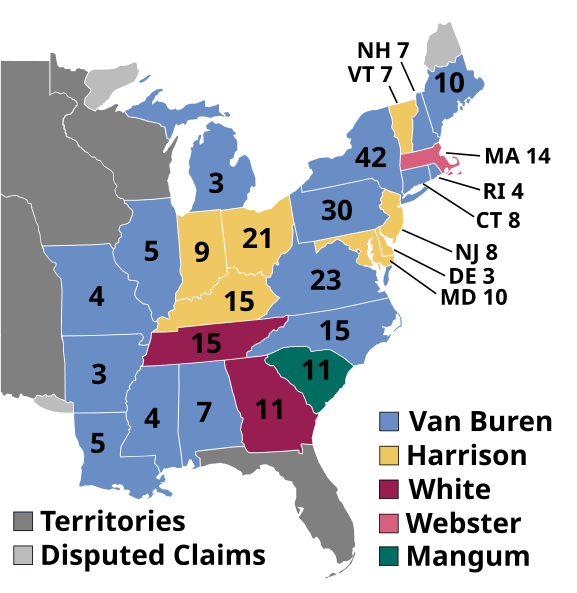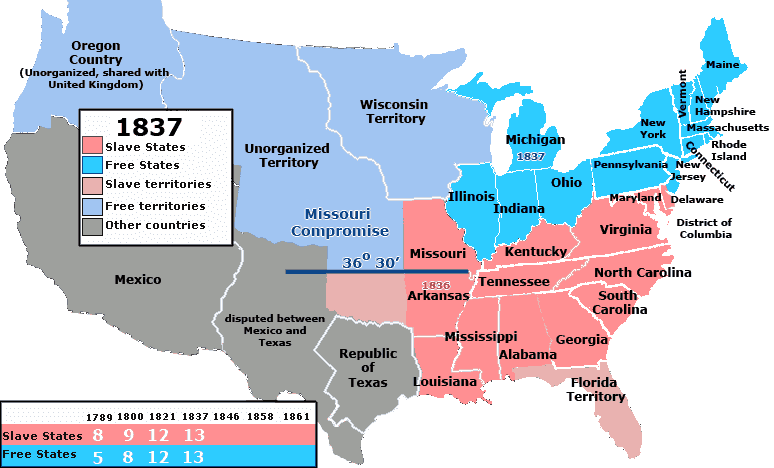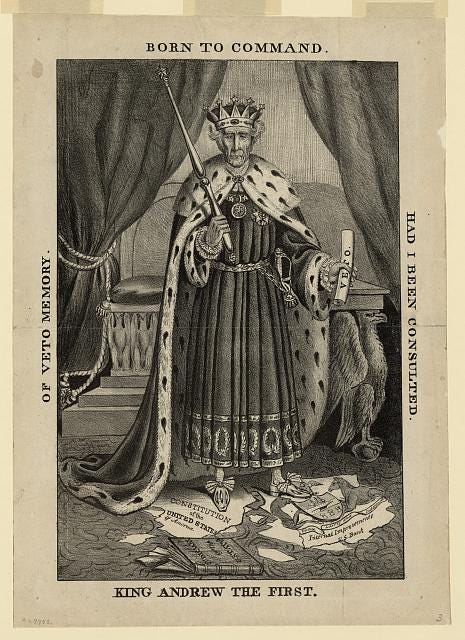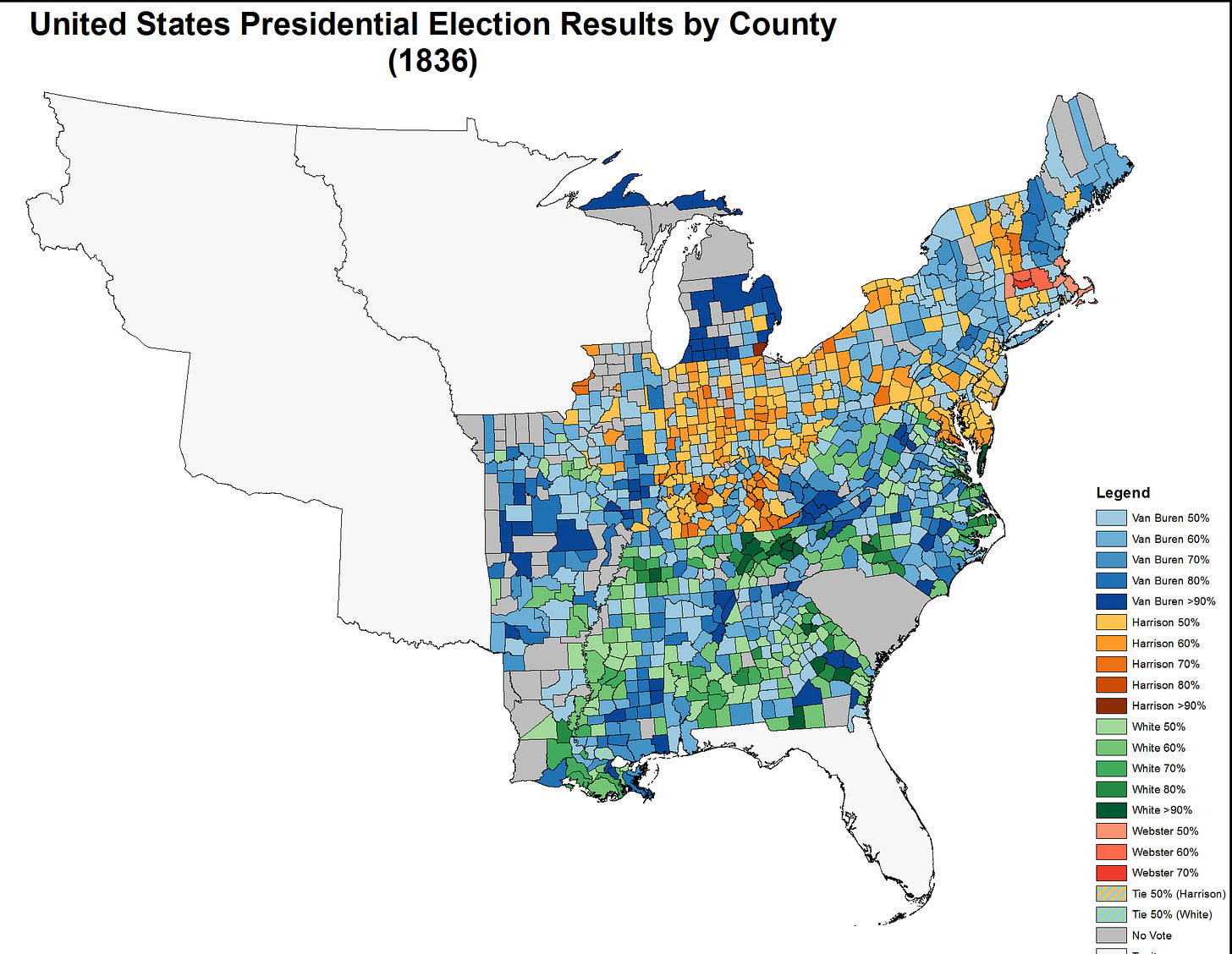Notes on the Presidential Election of 1836
post by Arjun Panickssery (arjun-panickssery) · 2025-02-13T23:40:23.224Z · LW · GW · 0 commentsThis is a link post for https://arjunpanickssery.substack.com/p/notes-on-the-presidential-election
Contents
Historical Background Political Situation The Issues The Campaign The Results None No comments
In 1836, Andrew Jackson had served two terms. In the presidential election, incumbent vice president Martin Van Buren defeated several Whig candidates.

Historical Background
By 1836, there were 25 states. States were often added in pairs (one slave and one free) to maintain political balance: Mississippi and Indiana, Alabama and Illinois, Missouri and Maine. Arkansas had just been added as a slave state in June 1836 and Michigan was due to be added in January 1837, making an exact 13-13 balance.
The population was 13 million with a center of mass in present-day West Virginia (part of Virginia then). Only New York City had more than 200,000 people, and Baltimore, Philadelphia, and Boston didn’t even have half as many. You can see from the electoral-vote allotments in the map above that there was a rising new region for politics beyond the North and South: the West, a swing region with their own politicians like Andrew Jackson and Henry Clay.
The Catholic immigration wave would come later and the country was still more than 96% Protestant, with Puritan-descended Congregationalists and Presbyterians in New England as well as Baptists and Methodists in the South (some motivated by the religious revivals of the Second Great Awakening). Slaves made up 15% of the population and about a third of the South. A few northern states like New Jersey had a small number of slaves due to gradual-emancipation laws that e.g. decreed that all children born after 1804 to enslaved mothers would be free when they reached adulthood.
Only in New York could black freedmen vote and only if they owned substantial property. Full manhood suffrage was in place otherwise as in most states during the 1820s and 30s (except in North Carolina, Virginia, or Rhode Island). South Carolina was the only state that still chose their electors via the state legislature rather than holding a popular vote at all.

Political Situation
The three regions had their priorities:
- The North was becoming more commercial and industrial. They favored protective tariffs and government intervention in the economy through the national bank and infrastructure improvements. They had some early abolitionists and were concerned about the spread of slavery to additional western states.
- The South was dominated by cotton and tobacco plantations and opposed tariffs for fear of retaliatory tariffs against American cotton. They were concerned with the preservation of slavery and the balance of power in the Senate between slave and free states. They emphasized states’ rights: South Carolina had recently lost the Nullification Crisis battle to President Jackson in 1832-33 when the state (with the support of South Carolina native John C. Calhoun) nullified a tariff within the boundaries of its state on the grounds that the tariff was unconstitutional.
- The West (which included Ohio/Indiana/Illinois as well as Kentucky/Tennessee and sometimes Alabama/Missouri) wanted cheap land, federal protection from Indian attacks, and infrastructure improvements. They broadly disliked “Eastern elites.”
The Second Party System was taking place after the turbulent era of Andrew Jackson (the incumbent president for the preceding eight years). He founded the Democratic Party with a broad populist coalition based on low tariffs, Indian removal, and opposition to the National Bank and internal-improvements spending. His opponents united to form the Whig Party, which was still loosely organized in 1836 but comprised
- Supporters of Henry Clay’s “American System” of a national bank and government infrastructure projects like roads and canals funded by high protective tariffs
- Disaffected Democrats such as Southern nullifiers
- Former members of the Anti-Masonic Party, a single-issue party based on opposition to Freemasonry
“Whig” was another term for “Patriot” i.e. supporter of American independence. The Whigs compared Jackson to a king and their main unifying principle was that they opposed executive overreach. Other coalition differences:
- Methodists and Baptists in many areas leaned Democrat, while Congregationalists and Presbyterians leaned Whig
- Small farmers, frontier settlers, and laborers leaned Democrat, while merchants, industrialists, and elites who favored national economic policy leaned Whig
- Northern urban machines like Tammany Hall supported Democrats while “old stock” New England families leaned Whig

The Issues
- The National Bank was the biggest issue. Jackson vetoed the recharter of the Second Bank of the United States in 1832 and withdrew federal deposits. The banking issue had existed since independence, when Alexander Hamilton pushed for the First Bank of the United States. This wasn’t a central bank that set monetary policy: it just held government deposits, issued specie-backed currency, and provided commercial banking services and business loans. It could help regulate private banks that issued bank notes by demanding they redeem its notes in gold or silver.
Jefferson and Madison opposed it on constitutional grounds since Congress was never granted the authority to establish a bank, but the Marshall court upheld it unanimously in McCulloch v. Maryland. Jackson’s veto in 1832 was popular because the common man was suspicious of banksters, and he won reelection easily, but it led to a spoils system where his “pet banks” were selected to receive surplus Treasury funds that they struggled to manage. This was believed to cause rampant land speculation which led in 1836 to Jackson’s Specie Circular executive order that government land could only be bought with gold and silver. The Bank War is often cited as related to the Panic of 1837, but that financial crisis only took place after the election. Ultimately there would be no national banking again until the 1860s. - Internal improvements was the buzzword for government infrastructure projects like those advanced by Clay’s American System. The Democrats generally opposed federal intervention in the economy and associated federal infrastructure projects with corruption; Jackson vetoed a number of internal-improvements bills including the Maysville Road.
- Tariffs and trade had reached a peak in the Nullification Crisis of 1832 and was still a live issue—with Whigs clearly pro- and Democrats clearly anti-tariff—but like the slavery question there was sensitivity among politicians for issues that were too sectional in nature, especially after the inconclusive outcome of 1832 in which Congress passed the Force Bill authorizing the president to deploy the army against South Carolina, whose state legislature convened two weeks later to repeal its original Nullification Ordinance but symbolically nullify the Force Bill itself.
- Slavery was similarly downplayed. The House of Representatives in 1836 had adopted the “gag rule” forbidding any discussion of slavery. Van Buren supported the gag rule but was a New Yorker and sometimes viewed suspiciously by Southerners.
- The Texas Revolution concluded in April 1836 after the American colonists led a revolt from Mexico with the founding of the Republic of Texas. One of the motivations for the revolution was that Mexico had abolished slavery in 1829. Jackson had recognized Texas’s independence but didn’t push for annexation, a policy that Van Buren would continue to avoid inflaming slavery debates or starting a war with Mexico. (Texas would eventually be annexed in 1845 and even more territory would be conquered in the subsequent Mexican-American War.)
The Campaign
Van Buren was Jackson’s handpicked successor and he arranged for an early convention (national conventions were new and had only begun in 1832) to head off any opposition. At the convention in Baltimore, Van Buren was nominated unanimously. Jackson’s preferred vice presidential nominee was Colonel Richard M. Johnson of Kentucky, a war hero from 1812 who was said to have personally killed Tecumseh. But Johnson only got one vote above the two-thirds majority that the convention rules required, because the Virginia delegation objected on the grounds that he had been openly in a long-term relationship with his slave Julia Chinn, whom he claimed was his common-law wife despite anti-miscegenation laws in Kentucky. (Ultimately upon his death, his children were prevented from inheriting.)
The Whigs weren’t organized enough by 1836 to hold a national convention, and ended up running multiple “favorite son” candidates in different states:
- William Henry Harrison was the main candidate in the North and West. He was a retired general from Ohio who was famous for winning the Battle of Tippecanoe against Tecumseh and associated tribes.
- Hugh Lawson White was the main candidate in the South. He was a senator from Tennessee (where Jackson had been a senator) and who broke with Jackson after disputes on states’ rights issues. His running mate was Senator John Tyler of Virginia, another former Democrat who turned against Jackson.
- Daniel Webster was a New England candidate who didn’t campaign nationally and only carried his home state of Massachusetts, where he was a senator.
- Willie Person Mangum was a North Carolina senator who was endorsed by the South Carolina legislature, which was led by John C. Calhoun’s minor Nullifier Party that only operated in South Carolina and whose single issue was the constitutionality of nullification. (Most supporters would later rejoin the Democratic party after Jackson left office.)
Henry Clay, the most prominent anti-Jackson politician, didn’t bother to run, thinking Van Buren to be too strong. The only way the Whigs could have won is if no candidate won a majority in the Electoral College, in which case the House of Representatives would choose the president by an election of one vote per state delegation.
Harrison cultivated a “common man” persona and leveraged his military reputation but the other Whig candidates stayed in their home regions. The Democrats had a superior political organization built by Van Buren and they campaigned on Jackson’s legacy of paying off the national debt, standing up to South Carolina, and killing the “monster bank.” The Whigs too ran ad hominem, calling “Little Van” a party hack who profited off the corrupt spoils system of patronage introduced by Jackson. In the South they also targeted Johnson’s interracial relationship.
BONUS: an anti-Van Buren campaign song (though this is from the 1840 campaign)
The Results
(Note that Michigan only become a state in January 1837 but cast its electoral votes before then. Congress didn’t decide to accept the results until afterward, and the inclusion didn’t swing the outcome of either the presidential or vice-presidential election in any case. A similar dispute had taken place with Indiana in 1816 and Missouri in 1820.)
There were 294 total electoral votes:
- Van Buren won a majority with 170 electoral votes (he needed 148) and carried 15 out of 25 states. He also won a narrow majority (51%) of the popular vote and even won the majority in both the North and South.
- William Henry Harrison won 73 electoral votes and 37% of the vote, mostly in the North and West.
- Hugh Lawson White won Georgia and his home state of Tennessee. Daniel Webster won his home state of Massachusetts. Willie Mangum was awarded the South Carolina’s electoral votes from its state legislature.

Van Buren won Pennsylvania (then the second-largest state) with only 50.6% of the vote, and would have failed to reach a majority if he had lost. Assuming a party-line vote, the Democrats would have narrowly prevailed in a contingent election because they won 14 out of 26 delegations in the House.
For the vice-presidential race, Virginia’s 23 electors chose to act as faithless electors and refused to vote for Johnson, which meant that Johnson was exactly one vote short of a majority. For the only time in history, the Senate decided the vice-presidential race in a contingent election. The Democrat-controlled Senate selected Johnson as Van Buren’s vice president.
William Henry Harrison would go on to unseat the incumbent Van Buren in 1840 and his vice president Tyler would serve the remainder of his term after his death. The Whigs would have two more presidents—Zachary Taylor and Millard Fillmore—before dissolving when politics became centered on the slavery question. Former Whigs Abraham Lincoln, Rutherford B. Hayes, Chester Arthur, and Benjamin Harrison would later serve as presidents under the Republican Party.
0 comments
Comments sorted by top scores.